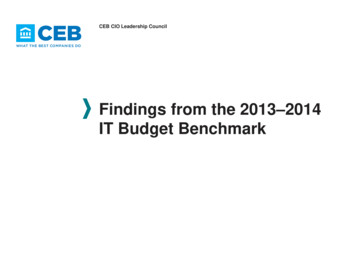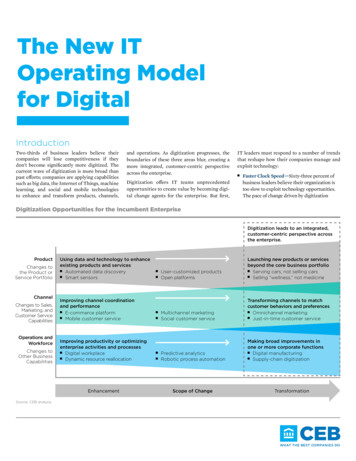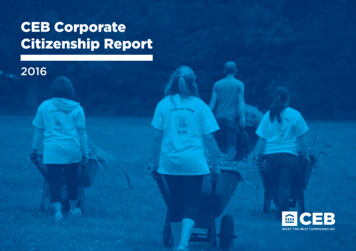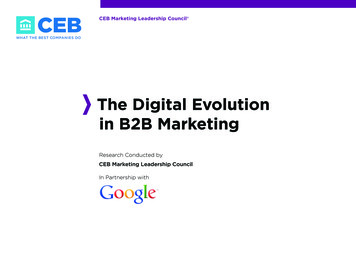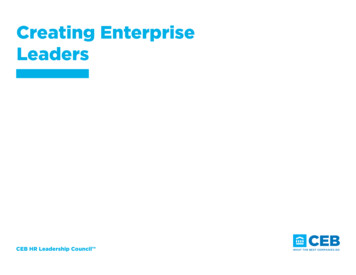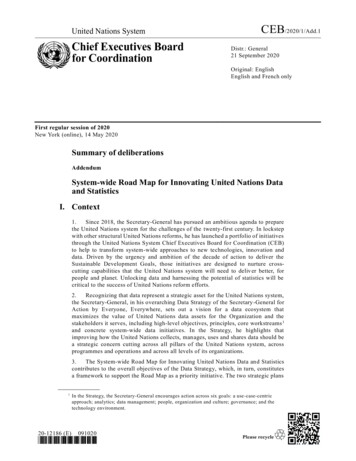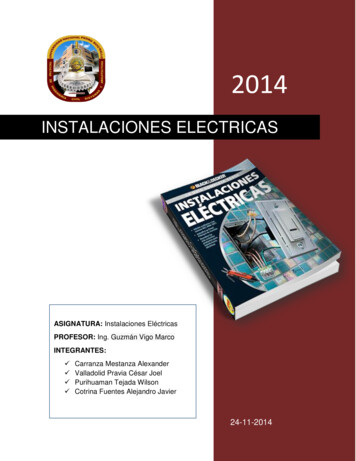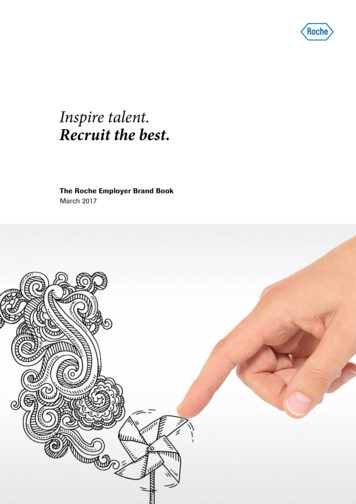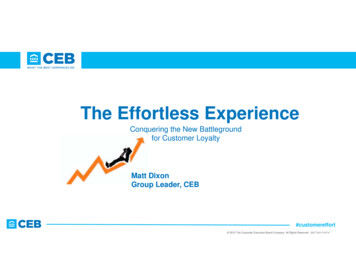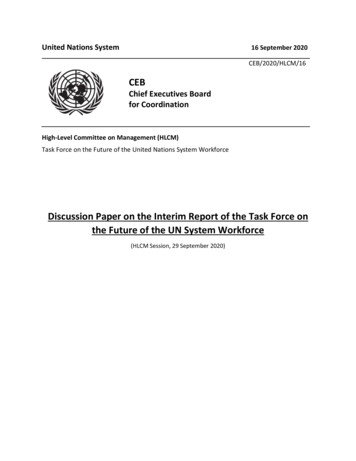
Transcription
United Nations System16 September 2020CEB/2020/HLCM/16CEBChief Executives Boardfor CoordinationHigh-Level Committee on Management (HLCM)Task Force on the Future of the United Nations System WorkforceDiscussion Paper on the Interim Report of the Task Force onthe Future of the UN System Workforce(HLCM Session, 29 September 2020)
CEB/2020/HLCM/16Page 2ObjectiveThis discussion paper is based on feedback received from HLCM members on the Interim Report of the CEBTask Force on the Future of the UN System Workforce through an online consultation process. The presentpaper lays the focus on areas of the interim paper that have attracted the most interest. It does notconstitute a comprehensive collection of all feedback. Specific recommendations on language, andorganizational experiences that have been received have been shared with the members of the Task Forceto ensure they are given due consideration.The objective of the discussion paper is to facilitate a targeted discussion of the Committee to guide thework of the Task Force for the coming months. HLCM is also asked for possible endorsements of elementsof the interim report. While the paper suggests discussion points, it should not preclude an open discussionof HLCM including on aspects and proposals not captured by the online consultation.Following the discussion and guidance of HLCM, the decision points that the Committee has decided onwill be acted on by the TF and its sub-groups. A further report will be issued in a more comprehensivemanner for discussion and decision by HLCM.Overall Assessment of the Interim Paper through initial feedbackMany organizations expressed general appreciation for the interim report and the work of the Task Force.The responsiveness and adjustment to the new realities that the Covid-19 pandemic has brought to thework of the UN system have been stressed as positive elements of the interim report. Many responsespositively highlighted the focus on “putting people first” in the proposed initiatives and lauded theincreased focus on the field. The need and usefulness of UN system cooperation and harmonization in thethree areas of work - remote working, an agile contract modality and enabling technology – was broadlyrecognized. Detailed elaboration of initiatives and recommendations was suggested as next steps for theTask Force. The necessity of a careful consideration of cost for all initiatives was highlighted. The inclusionof experiences, best practices and benchmarks from private- and public sectors was advised, as well as amore prominent place for environmental considerations.While the work of the Task Force was in general considered forward looking, there were divergent viewson the scope covered by the interim report. While some responses favored a prioritization of initiatives tofocus the energy of the Task Force, others advocated for a bolder and broader approach including moreinnovative ideas.In particular the inclusion of the following elements into the work of the Task Force was recommended:Feedback from multiple organizations advocated for the Task Force to develop a “family care leave policy”to address the needs of today’s diverse family configurations. Such a policy should be overarching anddesigned to include all family situations, not only limited to parental status, but include other caregivingcircumstances, such as self-care, or caring for elderly, siblings or other loved ones.The normalization and exploration of gains of part-time employment was mentioned by severalorganizations in their feedback. Connected to the work-life balance, flexible working through part-time orjob-sharing roles was deemed a key mechanism the UN could embrace and promote for all employees.
CEB/2020/HLCM/16Page 3It was also proposed that HLCM proceeded to endorsing the Leadership commitments 1 laid out inparagraph 20 of the Interim Report (see Annex I for the proposed language) as an important enabler ofcultural change. While the leadership commitments and engagement of senior staff were recognized as acrucial piece of the puzzle, a more prominent incorporation of the role of staff, including bottom-upengagement and empowerment, in the overall work of the Task Force was proposed.Suggested Discussion Points: Are there specific elements, e.g., as a family care leave policy or part-time work or other forwardleaning concepts, that would merit to be included in the Task Force’s forthcoming work? Is HLCM prepared to endorse the Leadership Commitments (as rephrased in Annex I) for the TaskForce to work on guidance on how to further formalize and operationalize the principles? Can HLCM support the interim paper and the overall direction of work of the Task Force for the nextmonths?Remote WorkingSeveral entities, based on internal surveys, reported a mostly effective and positive experience with remoteworking in the context of the Covid-19 pandemic. The notion that remote working will undoubtedlyconstitute an important feature of the “next normal”, and that a solid framework for remote working wouldbe needed was underscored in feedback received. The merit of coordination and some harmonizationamong UN system entities, taking into account differences in mandated activities, was generally recognized.Many organizations voiced support for the codification of the proposed remote working principles(paragraphs 28-35 in the interim report).One comment noted that the broader approach of “flexible working arrangement” instead of remoteworking might be considered more useful. Further integration of the remote working workstream with thecontractual modalities and technology streams was deemed desirable. The need for a remote workingframework or policy to encompass elements such as the responsibility and trust of staff and management,results-based performance evaluation, measurement of results and staff wellbeing was reinforced by someorganizations. Other points of focus that the Task Force should consider in detail comprised how theexamination of which functions can or cannot be performed remotely, entitlements and training formanagers and staff.While many organizations stressed a positive experience with short-term benefits in terms of productivityand staff satisfaction, some cautioned that broader and continuous analysis of the impact of remoteworking was necessary for success in the mid- and long term.A comparison of the impact of full-time remote work in contrast to part-time telecommuting was stated asan interesting was proposed as an interesting benchmark for the Task Force to consider. The usefulness ofa 50 mile radius as definition for “outside the duty station” was questioned by several commenters.1Putting people first; driving a passion for results; Embracing new leadership models; building trust; pursuing thesimplification of rules and policies; using technology to strengthen delivery; embracing learning; showcasing andadvancing diversity, inclusion and gender parity; creating an Employee Value Proposition; embracing the greatercause mindset: “A truly One UN”
CEB/2020/HLCM/16Page 4Suggested Discussion Points: Are any crucial elements missing from the focus area “Remote Working” of the interim report? Does HLCM support translating inter-agency principles into the elements of a system-wideframework that guides organizations’ remote working policies?Agile Contract ModalityThe proposal of an optional agile contract modality was overwhelmingly welcomed by respondents, withdoubts remaining among some participants. Making the UN a better employer of choice and a more diverseand inclusive workforce were expected benefits of an agile contract modality.The cruciality of firmly aligning new contract modalities with the proposal for remote working, and thenecessity of gathering input from and consulting with relevant stakeholders were emphasized in severalcomments. More information was sought on the relationship between existing modalities and the newmodality.It was stressed that any new modality should be designed to allow for sufficient flexibility for individual UNsystem entities to adapt the modality for their specific needs.Balancing the needs of staff members and the organization was mentioned by several organizations as animportant aspect for the Task Force to examine. Working conditions and well-being in general, family care,part-time work, career development, mobility and compensation were most cited as critical areas to betaken into account.A new contract modality was also seen as a possible option to harmonize non-staff modalities and thepossibility of introducing several options, including for general service staff living beyond commutingdistance was introduced.Suggested Discussion Points: Does HLCM support the development of a new contract modality? Which of the elements2 of laid out in the interim report, or which new elements do need particularemphasis during the development of the modality?Enabling TechnologyGeneral support was voiced by respondents for the assessment of the role of digital technology and for theproposed initiatives under this work stream. Recognition of benefits of collaboration, aligning andstandardizing processes through pilot projects was widespread. The inclusion of ICT experts and the HLCM’sDigital and Technology Network in pilot initiatives was recommended in some comments.The “Digital UN ID” project gained particular interest with some respondents and it was proposed thatHLCM recognize it as a priority.2Complementarity to existing contract modalities, agility, transparency around contract durations and predictability,career agility, simplicity of administration, financial sustainability, social protection, diversity and inclusion, flexibilityand virtual working arrangements, fairness transparency and insurance of accountability (the full elements can befound in paragraph 37 of the interim report).
CEB/2020/HLCM/16Page 5It was underscored in several comments that in all its endeavors the Task Force should carefully considersecurity and privacy implications. A cautious approach towards using AI was recommended by somerespondents, in particular for recruitment. The inclusion of AI experts was advised in this respect.Suggested Discussion Points: Are there missing elements in the assessment of the role of technology or the pilot projects? Does HLCM endorse the identified pilot project? Does HLCM support the Digital UN ID as a priority project?
CEB/2020/HLCM/16Page 6Annex I: Leadership CommitmentsLeadership Commitments, building on the UN System Leadership Framework, the lessons learnt from theCOVID-19 crisis and the challenges identified among entities.a. Putting people first by investing in and enabling our workforceb. Driving a passion for results and foster a “can do mentality” while holding people accountablec. Embracing new leadership models that foster greater collaboration with less hierarchy recognizingthat the future of work requires different skills and different delivery and operating modelsd. Building trust through authenticity, dialogue, courage and transparency authentic and courageousdialogue, transparency and accountability.e. Aggressively Systematically pursuing the simplification of rules and policies to enable fasterdecision-makingf.Using technology to strengthen delivery of results globally and enable new ways of workingregardless of locationg. Embracing learning and Career enhancement to foster and fostering growth mindsets and newskills for a volatile and increasingly complex worldh. Showcasing and advancing diversity, inclusion and gender parityi.Creating a clear Employee Value Proposition to position the UN System as an employer of choicej.Embracing the greater cause mindset: “A truly One UN”- this aims to foster a mindset that goesbeyond each organisation and genuinely places the common objectives first and people at thecenter.
CEB/2020/HLCM/16 Page 6 Annex I: Leadership Commitments Leadership Commitments, building on the UN System Leadership Framework, the lessons learnt from the COVID-19 crisis and the challenges identified among entities. a. Putting people first by investing in and enabling our workforce b.
